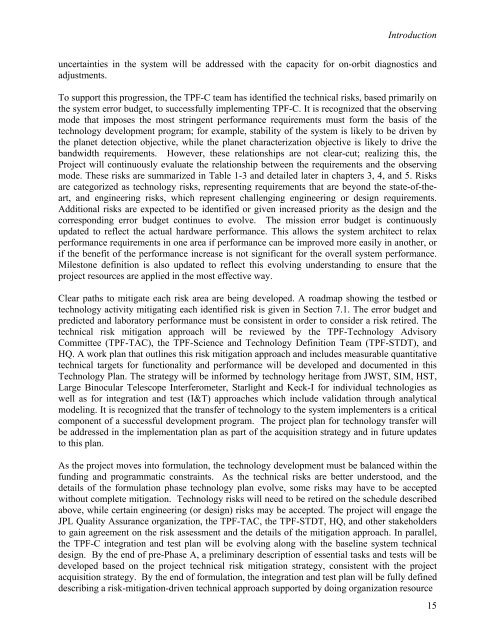TPF-C Technology Plan - Exoplanet Exploration Program - NASA
TPF-C Technology Plan - Exoplanet Exploration Program - NASA
TPF-C Technology Plan - Exoplanet Exploration Program - NASA
You also want an ePaper? Increase the reach of your titles
YUMPU automatically turns print PDFs into web optimized ePapers that Google loves.
Introduction<br />
uncertainties in the system will be addressed with the capacity for on-orbit diagnostics and<br />
adjustments.<br />
To support this progression, the <strong>TPF</strong>-C team has identified the technical risks, based primarily on<br />
the system error budget, to successfully implementing <strong>TPF</strong>-C. It is recognized that the observing<br />
mode that imposes the most stringent performance requirements must form the basis of the<br />
technology development program; for example, stability of the system is likely to be driven by<br />
the planet detection objective, while the planet characterization objective is likely to drive the<br />
bandwidth requirements. However, these relationships are not clear-cut; realizing this, the<br />
Project will continuously evaluate the relationship between the requirements and the observing<br />
mode. These risks are summarized in Table 1-3 and detailed later in chapters 3, 4, and 5. Risks<br />
are categorized as technology risks, representing requirements that are beyond the state-of-theart,<br />
and engineering risks, which represent challenging engineering or design requirements.<br />
Additional risks are expected to be identified or given increased priority as the design and the<br />
corresponding error budget continues to evolve. The mission error budget is continuously<br />
updated to reflect the actual hardware performance. This allows the system architect to relax<br />
performance requirements in one area if performance can be improved more easily in another, or<br />
if the benefit of the performance increase is not significant for the overall system performance.<br />
Milestone definition is also updated to reflect this evolving understanding to ensure that the<br />
project resources are applied in the most effective way.<br />
Clear paths to mitigate each risk area are being developed. A roadmap showing the testbed or<br />
technology activity mitigating each identified risk is given in Section 7.1. The error budget and<br />
predicted and laboratory performance must be consistent in order to consider a risk retired. The<br />
technical risk mitigation approach will be reviewed by the <strong>TPF</strong>-<strong>Technology</strong> Advisory<br />
Committee (<strong>TPF</strong>-TAC), the <strong>TPF</strong>-Science and <strong>Technology</strong> Definition Team (<strong>TPF</strong>-STDT), and<br />
HQ. A work plan that outlines this risk mitigation approach and includes measurable quantitative<br />
technical targets for functionality and performance will be developed and documented in this<br />
<strong>Technology</strong> <strong>Plan</strong>. The strategy will be informed by technology heritage from JWST, SIM, HST,<br />
Large Binocular Telescope Interferometer, Starlight and Keck-I for individual technologies as<br />
well as for integration and test (I&T) approaches which include validation through analytical<br />
modeling. It is recognized that the transfer of technology to the system implementers is a critical<br />
component of a successful development program. The project plan for technology transfer will<br />
be addressed in the implementation plan as part of the acquisition strategy and in future updates<br />
to this plan.<br />
As the project moves into formulation, the technology development must be balanced within the<br />
funding and programmatic constraints. As the technical risks are better understood, and the<br />
details of the formulation phase technology plan evolve, some risks may have to be accepted<br />
without complete mitigation. <strong>Technology</strong> risks will need to be retired on the schedule described<br />
above, while certain engineering (or design) risks may be accepted. The project will engage the<br />
JPL Quality Assurance organization, the <strong>TPF</strong>-TAC, the <strong>TPF</strong>-STDT, HQ, and other stakeholders<br />
to gain agreement on the risk assessment and the details of the mitigation approach. In parallel,<br />
the <strong>TPF</strong>-C integration and test plan will be evolving along with the baseline system technical<br />
design. By the end of pre-Phase A, a preliminary description of essential tasks and tests will be<br />
developed based on the project technical risk mitigation strategy, consistent with the project<br />
acquisition strategy. By the end of formulation, the integration and test plan will be fully defined<br />
describing a risk-mitigation-driven technical approach supported by doing organization resource<br />
15
















